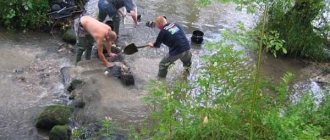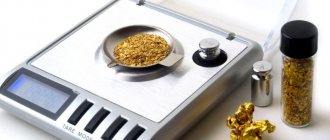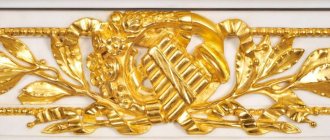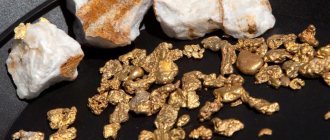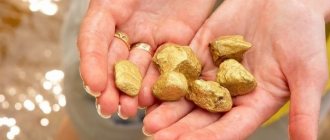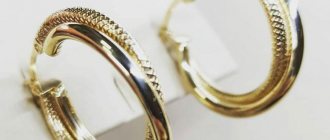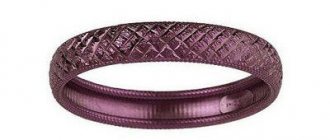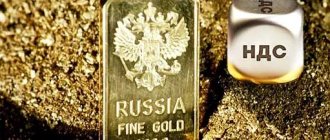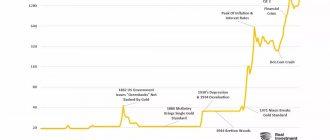To get gold, people use different tricks. Since the precious metal is rarely found in nugget form, several operations must be carried out before pure gold is extracted from the soil. Therefore, the question of how to extract gold from sand becomes relevant, especially for illegal miners.
The sand contains gold particles. They are usually small and found in the form of scales or grains. Sand, which contains the precious metal, can be found everywhere, but most often it is found on the banks of rivers, near alluvial placers. The material cannot be used, processing occurs only on an industrial scale, but prospectors are trying to get rich on their own and extract at least a little gold.
Mining gold from sand
Legal aspects of independent gold mining
Land resources can only be extracted under state control. The law requires that every miner register and pay taxes. Therefore, the extraction of precious metals is a licensed activity. Before production begins, it is necessary to register an individual entrepreneur or LLC and obtain a license and patent.
It is important to know! It doesn't matter where the river flows. Even if it is a stream in the yard of a private house, natural resources belong to the state, and they can only be extracted with special permission.
The main condition is that mined precious metals can only be sold to the state. The price is set by him, not by the miner. There is no need to count on excess profits, especially since gold ore requires additional processing. Impurities need to be removed, purified, and in some cases activated. When extracting technical gold from sand at home, you need to take into account that we are talking about raw materials that are inexpensive.
Identification of deposits in nature
In the era of free access to any information, it is not difficult to understand how to identify gold in a stone. But before that, you need to consider the list of the most promising places in which such a metal is likely to be present. Theoretically, particles of gold can be present in a wide variety of stones, but their quantity is so minute that it is not of particular value. If you want to engage in more serious mining, you need to count on luck and follow the principles of identifying deposits.
Cost of gold mining from sand
It all depends on where the work is done. When choosing a site for development, it is important not to end up on land occupied by large corporations. As a result, a scandal will break out, then there will be a trial, and you will have to suffer losses. But if the site is not occupied, you can use any method of amateur gold mining.
You should not expect huge profits if there is no gold mine nearby. So, in the Moscow region, having processed 1 cubic meter. meter of rock, you can get 0.2-0.6 grams. At current prices, the state will accept it for a couple of hundred rubles, and it will take two days to work. This is the case if manual gold mining technologies are used.
Profitability calculation
The use of technical means simplifies the process, but leads to additional costs. Therefore, before starting work, it is necessary to evaluate:
- Opportunity to obtain gold from sand in a selected area.
- The content of gold-bearing rocks in the soil and the quality of the precious metal.
- The price set by the government at the current moment in time.
- The ability to use modern technologies, their cost and operating costs.
- The ratio of expenses and possible profit. The profitability point is determined.
The last point is decisive. Sum up all current costs. Dividing it by the price of gold determines the amount of precious metal that must be mined daily. Taking into account the percentage of gold-bearing inclusions in the soil, the amount of rock that will have to be processed is determined.
If the productivity of the equipment allows you to wash more, the idea makes sense and the enterprise will be profitable. Otherwise, you need to use different technology and other methods. It is quite possible that the tray will become the only profitable way to get gold from sand at home.
How much in rubles?
The user's final loot was a mini-gold bar weighing just over 4.13 grams. All that remains is to implement it and calculate the daily profit. Unfortunately, this is where the main problem emerges. According to domestic legislation, artisanal mining of precious metals and their sale is an administrative violation. According to Article 19.14 of the Code of Administrative Offenses of the Russian Federation, a violator faces confiscation of gold and a fine of 3-5 thousand rubles.
Anastasia Gnedinskaya in her article “Predators or Miners” says that artisanal gold is usually sold through familiar jewelers who make jewelry out of it for a “small portion”, or through pawn shops. The latter accept “handicraft” as gold of the lowest standard 375, and in the best case (from acquaintance) as 500. That is, in the best case, they will be able to earn 5,500 rubles for a day’s production, and in the worst case, a little more than 4,000 rubles.
The costs of reagents can be ignored here, since they are small. Earning 4,000 a day can be considered quite decent, if not for its obvious illegality. However, as amateur prospector Vladimir Shilov told RIA Novosti, this fact stops few people. After all, even in the Moscow region you can earn over 300,000 rubles in a season from artisanal gold, and in Siberia – much more.
tstosterone.ru
(Visited 3,699 times, 1 visits today)
For centuries, gold was considered the most valuable noble metal, which played a key role in a wide variety of areas of human activity.
But if in ancient times there were no specific methods for extracting this material, in addition to developing mines, then today things are much better and it is possible to extract a certain amount of gold from stone.
How to obtain a mining permit
It is immediately necessary to make a reservation that the cost of the license must be included in the volume of the initial investment. The permit is valid for five years. After the five-year period has expired, the license must be renewed. The cost of licensing depends on the type of permit and the conditions that the document implies.
Specialized legal bureaus provide assistance with registration. This is the simplest way, but it involves payment of a reward. Collecting documents, submitting an application, going through the authorities, right up to obtaining a license, is undertaken by specialists. The principal can only wait for the procedure to be completed. However, the license price varies:
- Mining gold from sand at home. Gold placer will cost less - from 10,000 to 100,000 rubles.
- Development of gold ore deposits. Professional activity on an industrial scale costs from 15,000 to 200,000, but now it’s dollars.
It is important to know! The amount of the state fee for the initial registration of a permit is 7,500 rubles. The extension will cost 10 times less - 750 rubles.
The Ministry of Nature organizes a competition, which is held in the manner of a tender. Participants submit applications indicating the cost of the proposal. The best one in the auction wins. The permit requires the indication of a specific site for the industrial development of precious metals. But this is for large enterprises.
Important to remember! Starting from 2021, a commercial entity with the status of a legal entity or individual entrepreneur can obtain a license. Previously, permits were issued only to legal entities. Now any private entrepreneur can engage in development.
Profitability and laws
Legislation prohibits the extraction and sale of technical gold. To mine it, you will need to obtain a private miner's license. You can hand over the mined gold to the state, but it pays very little for it - about 20 kopecks per milligram. Trying to sell it to someone else can result in punishment under the Criminal Code.
Most likely, you will not come across gold on an industrial scale, since the richest deposits have long been occupied by gold mining companies, and if you mine gold on their territory, you can get into trouble. Other places are not so rich in gold; for example, in the Moscow region, the soil contains 20-60 milligrams of gold per cubic meter of rock. Accordingly, it will take several days to extract a gram of gold, and you will have to work hard, but you will then receive about two hundred rubles for it. But most local miners still pursue other goals. They do this not to get rich, but for pleasure. There are even competitions for such “treasure hunters.”
Where is the best place to mine gold?
Golden sand is obtained by washing out grains from rock. Therefore, there is more of it in the rivers that flow past the deposit. Most often these are mountain rivers with an average flow, sufficient to wash silt out of the tray. With the industrial approach, geological exploration is carried out. True, it is expensive.
You can contact residents of surrounding communities for help. Even if they don't point to the location, at least it will be clear whether the desired metal is there as such. Checking for availability is carried out in several stages as you move upstream. Even if someone had worked before, this does not mean that the gold particles were not deposited again by the current.
Top 10 Russian rivers rich in gold reserves
Gold can be found in the following places:
- Lena River basin. Over one and a half hundred years of industrial production, about 1.5 tons of precious metal were mined here. There is still enough gold left in abandoned deposits for private miners.
- Bom River (Amur Region). The yellow metal is found throughout the Bohm. In some places, prospectors find gold deposits where it lies right in the riverbed. Nuggets are often found, the largest reaching 300-400 g.
- Millionny Stream (Amur Region). Placers of gold were accidentally discovered by smugglers at the end of the 19th century. In the first month, we managed to wash about 650 kg of metal.
- Unakha River (Amur Region). Mountain river with fast flow. Gold is found where the bottom is exposed.
- Jalon stream (Amur region). The rich part of the seam (more than 2 kg of gold per 1 ton of sand) has already been developed, but there is still room for enthusiasts with metal detectors.
- Bodaibo River (Irkutsk region). The alluvial gold here is large. There are grains with a diameter of 8 mm or more.
- Bolshoy Chanchik River (Irkutsk region). Tributary of the river Bodaybo. The riverbed has already been dredged, but large nuggets are still found.
- Alekseevsky stream (Kamchatka region). Famous for large nuggets weighing up to 1 kg.
- Talga River (Khabarovsk Territory). It has been exploited since the end of the 19th century, but large nuggets are still found today.
- Sanarka River (Chelyabinsk region). Here were the richest deposits of precious stones and metals, which had been mined since the end of the 19th century. Currently, there is no industrial gold mining in Sanarka.
Those wishing to try themselves as a private miner should remember that they must purchase the appropriate license. Otherwise, fishing will be illegal.
Instructions for Beginners
As additional manual equipment, a sieve placed on a tray is used. It will separate large stones from small particles. In addition, you must adhere to the following recommendations:
- It makes sense to choose a place where a tree has fallen into the water or large stones are visible from it.
- The optimal depth of the river is 15 cm. If you get closer to the shore, silt and debris will become a problem. Move further away and it becomes more difficult to work.
- You need to look in the upper layer of bottom rocks. At a depth of up to 10 cm there are small grains. From 10 to 30 cm – small nuggets. More – 30 large specimens.
Important to remember! You can make a mistake when washing. Mica interferes with its shine. Pyrite is a mineral that looks like gold-bearing sand grains.
Do not assume that the work is seasonal. In winter, it becomes even easier to do. You can travel over rough terrain on skis. It is in frozen water that the current transports particles. Panning is the easiest and most inexpensive way to extract gold from sand at home. The entire list of methods is divided into types.
How to use a gold pan
Using a tray, precious metal is mined in the traditional (manual) way. To do this, sand is lifted from the bottom of the reservoir and placed in a tray. The best depth for work is 15 cm. Then the tool is immersed in water and circular movements are performed.
The sludge is washed, leaving light particles that do not contain metal. Final purification with separation of heavier fractions can be carried out at home. How to extract grains of gold from sand is described above.
Next, watch a visual video of one of the methods of gold mining:
Extraction technologies
In addition to manual tray washing, there are other methods that are also successfully used in practice. And it's not just about diligence. If the romance of untouched nature is not enough, and you want to earn more, you can use the following methodology:
- Amalgamation . Production is expected. Mercury is used as an active reagent. The danger is that its vapors can cause irreparable harm to health. The state carefully monitors such productions.
- Cyanidation . A chemical reaction is also assumed to occur. In this case, hydrocyanic acid is used, which dissolves the precious metal. Compounds are created that are subsequently processed.
These are not the most expensive methods. Mining development is more expensive, but if the location is chosen correctly, this business can bring in millions. And the listed methods will also require start-up investments.
Important feature! You need laboratory equipment, a room with good ventilation, devices that capture harmful gases, etc. Supervisory authorities often work at such production facilities. Environmentalists, labor safety inspectors, tax officials, etc. come to carry out inspections.
Therefore, when extracting gold from sand, miners most often use trays.
Romance or earnings
Prospectors are divided into two categories. Some people need vivid impressions, privacy, excitement, and earnings come in the background. Others live by it. Naturally, both of them dream of finding the biggest nugget. And such cases do happen. It is important to know how to search correctly. You immediately need to determine what the earner wants:
- Sand deposits . Sieves are used, washing is carried out more thoroughly, and the water pressure is set more powerfully. The upper layers of bottom sediments are washed.
- Nuggets . Only large sieves are used, the washing is less active, so as not to wash the nugget into the river. Soil lying at a depth of more than 0.3 meters is subject to washing.
The difficulty is that manually selecting bottom soil to a depth of 30 cm to 1 meter is physically difficult. One tray is not enough. You need a tool that allows you to scoop up rock. Pumping equipment and mechanization are used, which also costs money.
Illegal mining: what threatens “black” miners
The legislation provides for two types of liability if gold is mined illegally. The Administrative Code provides for a fine of 3 to 5 thousand rubles. Equipment will not be confiscated. But this is only if the volume of precious metal mined has a cost of less than 1,000,000 rubles. Otherwise, the Criminal Code comes into force, since the amount is especially large. But criminal structures and competitors pose a greater danger to illegal immigrants working illegally.
Practice has shown that they, without a twinge of conscience, hand over “their brother” to law enforcement agencies. They do not receive any profit. But they take away the equipment, space, etc. There are many cases where people were killed in remote parts of the country. There is a place for racketeering in this area. The fact is that a “black miner” cannot contact the police, since he himself works illegally.
Advantages and disadvantages
In principle, the main advantage of the procedure described above is the low cost of chemicals and ease of manipulation.
However, in order to seriously engage in such gold mining, it is necessary:
- clearly understand which items specifically contain precious metals;
- where to find recyclable materials for recycling.
At the same time, the legislation directly prohibits any gold mining without obtaining official permission.
Another problem is that the further you go, the more difficult it is to find gold-containing objects for little money.
Risks and prospects of home gold mining
When mining gold at home legally, you have to buy specialized equipment. These are pumps, sieves, gutters, etc. If we are talking about processing, then you will need reagents, laboratory equipment and furniture. Not every businessman is able to recoup his expenses.
There are risks, as in any business. However, interest in mining activities has not waned for centuries. The reason lies in the fact that this metal has never fallen in price. Minor fluctuations in the precious metals market occur, but the cost per gram becomes higher and higher as a result. No inflation is scary. This is the main difference between gold reserves and foreign exchange reserves.
Animation diagram of the operation of the EG installation for disintegration
To confirm the effectiveness of EG technology in comparison with classical methods, a number of experiments were carried out on the enrichment of high-clay gold-bearing sands.
The starting material of the sample was subjected to processing with EG technology, which consists in washing the clay from the mineral component of the sample. In addition to EHT, the disintegration of the clay fraction was carried out in a scrubber drum and manually under running water. After disintegration, the resulting material was separated on a 2 mm sieve, releasing sand (+2 mm) and clay (-2 mm) fractions. The clay fraction was further enriched on the SKL-2 concentration table.
After separating the sample into sand and clay using electro-hydraulic technology, the resulting sand fraction was sent for chemical analysis using the atomic adsorption method. The gold content in the sands is 0.51 g/t. Given that the average gold content of the processed high clay sands is 0.2 g/t, most of the gold remains in the sand and is available for further beneficiation.
Results of chemical analysis of washed sand
| Product | Weight, gr. | Au content, g/t |
| Sand | 1446,79 | 0,51 |
Next, experiments were carried out on the gravitational enrichment of the clay part of the sample using the SKL-2 concentration table. According to the results of the gravity experiment, gold recovery in the concentrate is 2.47% with a content of 0.15 g/t in the gravity concentrate.
Results of gravity enrichment of clay fraction
| Product | Exit, % | Au content, g/t | Au recovery, % |
| Gravity concentrate | 0,67 | 0,15 | 2,47 |
| Tails of gravity | 99,33 | 0,04 | 97,53 |
| Total ore: | 100 | 0,04 | 100 |
The obtained indicators of separation of the clay component from the granular part of the sample confirm the effectiveness of the EG technology. As a result of processing the material with EHT, the main part of the gold was concentrated in the sand fraction. The clayey part is not suitable for further gravity enrichment.
Also, together with the disintegration of high-clay sands using the EG technology, experiments were carried out in parallel on washing the clay fraction in a scrubber drum and manually.
